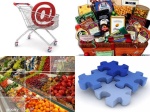
Benefits of Market Basket Analysis
With the background information about Market Basket Analysis, which we saw in the previous post, let us try and understand how a retailer can leverage the information obtained by doing such an analysis and reap benefits.
a) Pricing Strategies: When we know, which of the SKUs have greater affinity, we can devise pricing strategies accordingly. For instance, let us assume that there are 2 SKUs Bread & Eggs, which have a strong association. (Confidence of 80%). There is another SKU – Cheese Spread, which has a lesser association with Bread – Confidence of 60%. Let us assume that this retailer generally gives a mark down of Eggs on every Friday. Now by doing a Market Basket Analysis, if the retailer finds that the Eggs will be sold whenever Breads are sold (irrespective of the day of week), that may mean that the sale of eggs is not so influenced by the mark down on Eggs on Friday. Thus, the retailer can infer that instead of marking down the price of Eggs, if the Cheese Spread is sold at a discounted price, the sales dollars may go up. This is one benefit of doing a Market Basket Analysis, explained in an elementary way.
b) Display of SKUs: In bigger retail store chains, the arrangement or display of SKUs in store shelves can be modified based on the inference out of Market Basket Analysis. For instance, there are 2 SKUs – A1 & A2 located far from each other in a store, but which are proven to have strong affinity. In that case, the retailer may choose to bring A1 and A2 nearby in the shelves so that the ease of buying for customer is improved. Sometimes it may so happen that the retailer may move out 2 SKUs having close association so that the customer is made to walk the stretch which may increase the probability that he/she will look at other SKUs which may be converted to an unplanned purchase. These two seemingly opposing strategies will be used differently by different retailers depending on several attributes of SKUs.
c) Customized Coupons: If Market Basket Analysis is performed on a customer-to-customer basis, then purchasing behaviour of the consumer can be studied better. Many matured retailers do this and solicit coupons and offers based on what the customer “may” buy instead of publishing the same coupons for all customers of a store. For instance, if the customer is expected to buy a pack of 6 cans of beer and a Lays medium sized pack during every visit, then customized coupons such as $2 off on 12 cans of beer or $1 OFF on a Family Pack of Lays etc can be offered to him, instead of issuing a coupon to buy bananas at a discounted price, which he may not purchase at all. If the customer is purchasing only on Sundays every week, then he can be offered a coupon that expires on a Thursday in an attempt to increase the frequency of his visit to the store.
d) Sales Influencers: MBA can also be used to study the trend in the purchase of a certain SKU. For instance, if the association between 2 SKUs has been very strong till some point in time and then suddenly decreases, that might be because of the following reasons:
- The price of one of the SKUs is increased
- The shelf-stock of one of the SKUs is decreased
- A new brand of one of the SKUs was introduced
- An old brand was removed from the catalogue etc.,
This will help a retailer to understand the influence of these activities on the sales figures.
These are just some of the ways that a retailer can put to use, the results of Market Basket Analysis. Hope this gives a fair basic understanding.

